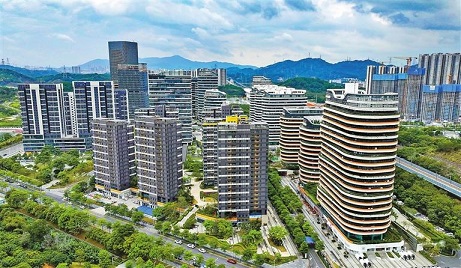Shenzhen
 2024/7/16
2024/7/16
 source: Shenzhen Daily
source: Shenzhen Daily
 Print
Print

A view of Guangming Science City.Liu Xudong
Windy Shao
windysjf@hotmail.com
THE “Regulations on Advancing the Development of Guangming Science City in the Shenzhen Special Economic Zone,” the first regulations for a science city in China, came into effect June 1, 2023.
These regulations are specifically tailored to meet the unique needs of a science-focused area, and introduce new frameworks for governance, land planning, technology, talent, and finance. Their primary goal is to strengthen scientific infrastructure, support national strategic capabilities, encourage innovation, and establish a leading position in the global scientific community.
One year on, the impact of these regulations is clear. From bolstering research and industrial sectors to attracting top-tier talent and investment, Guangming Science City has seen a remarkable evolution.
The regulations envision the science city becoming a leading national scientific center within the Guangdong-Hong Kong-Macao Greater Bay Area. Since its establishment in 2019, the science city has been dedicated to expanding its scientific and technological prowess.
The regulations also offer robust policy backing and financial security in crucial areas like technology financing, talent cultivation, and intellectual property protection.
Talent attraction has also been prioritized, leading to a surge in high-caliber professionals and researchers choosing Guangming Science City as their home. The area is now home to 6,087 talented individuals from various research institutes and academies.
In addition, the local government has launched the Intellectual Property Public Service Center to simplify patent processes, allowing entities to swiftly register patents and access significant funding. The center is revolutionizing intellectual property services by tailoring offerings to research teams and innovative entities, resulting in 10.5 billion yuan (US$1.45 billion) in pledged intellectual property financing so far.
Key facilities
The science city has planned 24 key facilities of innovation. Currently, 20 of them have been completed or are under construction.
Notable advancements include the operational synthetic biology research facilities and brain analysis and simulation centers, alongside the swift development of the Pengcheng Cloud Brain Phase III and the creation of research facilities for special environmental materials and devices. The Shenzhen Medical Academy of Research and Translation has been established, and the Shenzhen Bay Laboratory and the Artificial Intelligence and Digital Economy Guangdong Provincial Laboratory (Shenzhen) have been operating smoothly.
Cross-border
collaboration
To date, the science city has attracted 54 international projects from 13 countries and regions.
Meanwhile, the Guangming Science City Hong Kong Operations Center, which acts as a key hub for collaboration between research institutions and firms from Hong Kong, has been established. This center aims to encourage joint scientific efforts and the shared use of infrastructure.
Transformation
platforms
The regulatory landscape has been instrumental in advancing scientific and technological achievements within the science city, facilitating the establishment of transformation platforms.
In July 2023, approval was secured for the establishment of China’s first national industrial innovation center for bio-manufacturing in Guangming, which will help Shenzhen create a thriving bio-manufacturing industry cluster.
Currently, the industrial innovation centers for engineering biology and brain science and technology have attracted 167 companies with a total valuation of 33 billion yuan. The Guangming Biomedical Innovation Center has started operations, and the district has built the first ultra-high-throughput drug screening platform in South China.
Tech innovation
Firms in Guangming Science City have achieved significant successes in technological innovation. The Gentle Flex series cell processing system developed by CellBri has become the first domestically produced equipment for cell and gene therapy to be publicly disclosed by the U.S. Food and Drug Administration as a filing product.
Wingor Biotechnology’s innovative drug for the treatment of acute ischemic stroke has become the city’s first stem cell drug approved for clinical trials.
Sunwoda has developed the world’s first ultra-fast charging “Flash Charge Battery 3.0,” which is capable of charging from 20% to 80% in just 10 minutes.
The industrialization of the science city’s scientific and technological achievements is gaining momentum, which is particularly evident in burgeoning sectors like brain science and brain-machine engineering.
The science city is now home to 60 companies in this field, and their total valuation exceeds 10 billion yuan.





